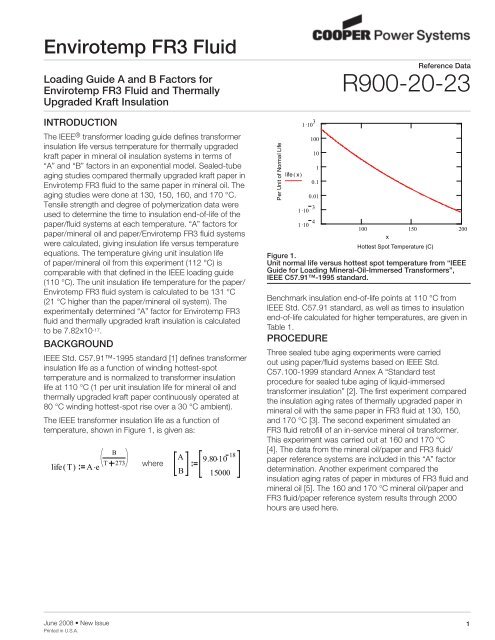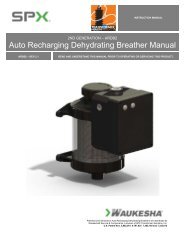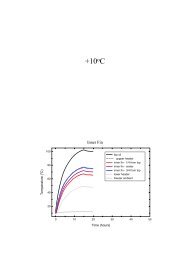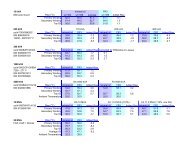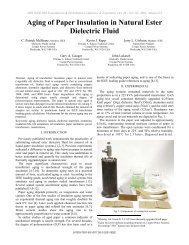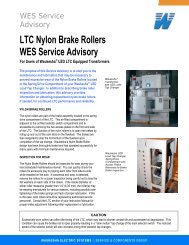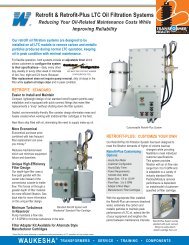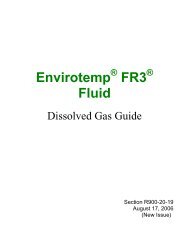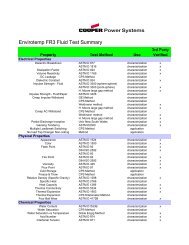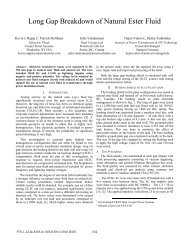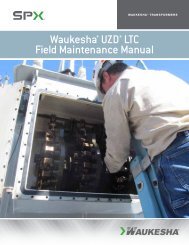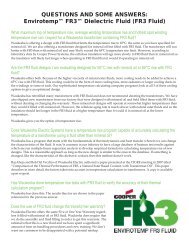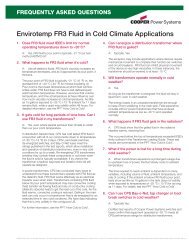R900-20-23 - SPX Transformer Solutions
R900-20-23 - SPX Transformer Solutions
R900-20-23 - SPX Transformer Solutions
You also want an ePaper? Increase the reach of your titles
YUMPU automatically turns print PDFs into web optimized ePapers that Google loves.
Envirotemp FR3 FluidLoading Guide A and B Factors forEnvirotemp FR3 Fluid and ThermallyUpgraded Kraft InsulationINTRODUCTIONThe IEEE ® transformer loading guide defines transformerinsulation life versus temperature for thermally upgradedkraft paper in mineral oil insulation systems in terms of“A” and “B” factors in an exponential model. Sealed-tubeaging studies compared thermally upgraded kraft paper inEnvirotemp FR3 fluid to the same paper in mineral oil. Theaging studies were done at 130, 150, 160, and 170 °C.Tensile strength and degree of polymerization data wereused to determine the time to insulation end-of-life of thepaper/fluid systems at each temperature. “A” factors forpaper/mineral oil and paper/Envirotemp FR3 fluid systemswere calculated, giving insulation life versus temperatureequations. The temperature giving unit insulation lifeof paper/mineral oil from this experiment (112 °C) iscomparable with that defined in the IEEE loading guide(110 °C). The unit insulation life temperature for the paper/Envirotemp FR3 fluid system is calculated to be 131 °C(21 °C higher than the paper/mineral oil system). Theexperimentally determined “A” factor for Envirotemp FR3fluid and thermally upgraded kraft insulation is calculatedto be 7.82x10 -17 .BACKGROUNDIEEE Std. C57.91-1995 standard [1] defines transformerinsulation life as a function of winding hottest-spottemperature and is normalized to transformer insulationlife at 110 °C (1 per unit insulation life for mineral oil andthermally upgraded kraft paper continuously operated at80 °C winding hottest-spot rise over a 30 °C ambient).The IEEE transformer insulation life as a function oftemperature, shown in Figure 1, is given as:life ( T) A.eBT 273whereAB9.80.10 1815000Reference Data<strong>R900</strong>-<strong>20</strong>-<strong>23</strong>1 . 10 3 100101life ( x)0.10.011 . 10 31 . 10 4100 150 <strong>20</strong>0xHottest Spot Temperature (C)Figure 1.Unit normal life versus hottest spot temperature from “IEEEGuide for Loading Mineral-Oil-Immersed <strong>Transformer</strong>s”,IEEE C57.91-1995 standard.Per Unit of Normal LifeBenchmark insulation end-of-life points at 110 °C fromIEEE Std. C57.91 standard, as well as times to insulationend-of-life calculated for higher temperatures, are given inTable 1.ProcedureThree sealed tube aging experiments were carriedout using paper/fluid systems based on IEEE Std.C57.100-1999 standard Annex A “Standard testprocedure for sealed tube aging of liquid-immersedtransformer insulation” [2]. The first experiment comparedthe insulation aging rates of thermally upgraded paper inmineral oil with the same paper in FR3 fluid at 130, 150,and 170 °C [3]. The second experiment simulated anFR3 fluid retrofill of an in-service mineral oil transformer.This experiment was carried out at 160 and 170 °C[4]. The data from the mineral oil/paper and FR3 fluid/paper reference systems are included in this “A” factordetermination. Another experiment compared theinsulation aging rates of paper in mixtures of FR3 fluid andmineral oil [5]. The 160 and 170 °C mineral oil/paper andFR3 fluid/paper reference system results through <strong>20</strong>00hours are used here.June <strong>20</strong>08 • New IssuePrinted in U.S.A.1
Loading Guide A and B Factors for Envirotemp FR3 Fluid and Thermally Upgraded Kraft InsulationTABLE 1Normal insulation life of a well-dried, oxygen-free 65 °C average winding temperature rise insulation system at the referencetemperature of 110 °C [times at 150, 160, 170 °C calculated using t = life(T) x endpoint]. From “IEEE Guide for Loading Mineral-Oil-Immersed <strong>Transformer</strong>s”, IEEE Std. C57.91-1995 standard.Time to End Point (hrs)End-of-Life Basis 110 °C 150 °C 160 °C 170 °C50% retained tensile strength 65,000 (7.4 yrs) 1,602 706 3<strong>23</strong>25% retained tensile strength 135,000 (15.4 yrs) 3,327 1,467 671<strong>20</strong>0 degrees of polymerization 150,000 (17.1 yrs) 3,697 1,630 746IEEE composite “normal” life180,000 (<strong>20</strong>.5 yrs)TABLE 2Time to insulation life end point, in hours and unit life of IEEE Std. C57.91 standard unit life for paper in mineral oil and FR3 fluidcalculated from curve fits of experimental results. A double exponential model was used except for mineral oil systems at 150 °CTime to End Point (hrs)Unit Life(Time to End Point)/(IEEE 110 °C Basis)Temperature Tensile Strength DvP Tensile Strength DvPFluid (°C) 50% 25% <strong>20</strong>0 50% 25% <strong>20</strong>0Mineral oil 150 3,179 2 4,086 2, * 3,462 1 0.049 0.030 0.0<strong>23</strong>160 1,401 2,678 1,800 0.022 0.0<strong>20</strong> 0.012170 384 742 534 0.0059 0.0055 0.0036FR3 fluid 160 5,9<strong>20</strong> 13,530 * 13,050 * 0.091 0.100 0.087170 1,400 6,107 * 3,335 0.022 0.045 0.022* extrapolated1btsingle exponential: y ( t)= ae2 sigmoidal:y t)=1+ea−bt−dt( double exponential:⎛ t −t0−⎜⎝ b⎞⎟⎠y(t)= ae+ ceresultsAt 130 °C, neither the paper/mineral oil system nor the FR3fluid/paper system reached any IEEE benchmark end-of-lifepoints by the end of the test. At 150 °C, the FR3 fluid/papersystems again did not reach benchmark end-of-life points.Mineral oil/paper reached nearly all benchmark end-of-lifepoints (50% retained tensile strength, 25% retained tensilestrength, and <strong>20</strong>0 degrees of polymerization) at 150, 160,and 170 °C. The one exception was 25% retained tensilestrength at 150 °C. The duration of the 150 °C experimentwas 4000 hours; we extrapolated the data to reach the25% retained tensile strength time of 4086 hours.Paper in FR3 fluid reached 50% retained tensile strengthduring the 160 °C test duration, and 50% retained tensilestrength and <strong>20</strong>0 degrees of polymerization at 170 °C. Thetimes to other end-of-life points were extrapolated from thetest data.For paper in mineral oil at 130 °C, paper aging didnot progress far enough to allow extrapolation to anybenchmark end-of-life points. For paper in FR3 fluid, neitherpaper aging at 130 °C nor 150 °C progressed far enoughto extrapolate to any benchmark end-of-life points. Thedetermination of the mineral oil/paper “A” factor uses 150,160, and 170 °C data; “A” for FR3 fluid/paper uses 160 and170 °C data.Generally, the simplest equation of physical significancethat reasonably represents the data is used to modelexperimental results. A single exponential model fits muchof the tensile data well. However, when extrapolatingbeyond the experimental data range, the single exponentialmodel does not give realistic values of time to end-of-life.A double exponential model is usually used for degree ofpolymerization [6]. Except for mineral oil at 150 °C, a doubleexponential model was used to fit both tensile and degreeof polymerization aging data. The double exponentialmodel gave realistic values when extrapolating beyondexperimental data to estimate time to end-of-life.Degree of polymerization and retained tensile strengthresults from the three experiments are used to estimate “A”factors for both the paper/mineral oil and paper/FR3 fluidsystems. Because the temperature range over which thetime to insulation end points were determined is small, theslope (“B” factor) of the unit life versus temperature curvesis assumed to be parallel to that given in IEEE Std. C57.91standard. The results are shown in Table 2 and Figure 2.Assuming that the life versus temperature curve for FR3fluid is parallel to the curve for mineral oil (“B” constant),the Table 2 unit life for each temperature and end pointare used to estimate “A” (iterative Levenberg-Marquardtmethod). The estimated “A” factor is used to calculate theper unit insulation life at 110 °C and the temperature givingunit insulation life (Table 3 and Figure 3). The temperaturecalculated from experimental data to give unit insulation lifein mineral oil (112 °C) is reasonably close to the temperaturedefined in IEEE Std. C57.91 standard (110 °C).2
Loading Guide A and B Factors for Envirotemp FR3 Fluid and Thermally Upgraded Kraft InsulationTABLE 3Comparison of insulation unit life of thermally upgraded Kraft paper in FR3 fluid and mineral oil.Mineral OilFR3 fluid“A” factor 9.80 x 10 -18 7.82 x 10 -17Unit Life 110 °C 1.00 7.98131 °C 0.13 1.001<strong>20</strong>0Retained Tensile Strength (% unaged)100806040<strong>20</strong>mineral oil - sealed tubemineral oil - retrofillmineral oil - blendingFR3 - sealed tubeFR3 - retrofillFR3 - blendingDegree of Polymerization1000800600400<strong>20</strong>0mineral oil - sealed tubemineral oil - retrofillmineral oil - blendingFR3 - sealed tubeFR3 - retrofillFR3 - blending00 1000 <strong>20</strong>00 3000 4000Time at 170 o C (hrs)00 1000 <strong>20</strong>00 3000 4000Time at 170 o C (hrs)Retained Tensile Strength (% unaged)100755025mineral oilretrofillblendingFR3retrofillblendingDegree of Polymerization1<strong>20</strong>01000800600400<strong>20</strong>0mineral oilretrofillblendingEFR3retrofillblending00 1000 <strong>20</strong>00 3000 4000 5000 6000 7000Time at 160 o C (hrs)00 1000 <strong>20</strong>00 3000 4000 5000 6000 7000Time at 160 o C (hrs)Retained Tensile Strength (% unaged)100755025mineral oilFR3(error bars = 1σ)00 1000 <strong>20</strong>00 3000 4000Time at 150 o C (hours)Figure 2.Sealed tube accelerated aging test results for paper/mineral oil and paper/FR3 fluid systems.Degree of Polymerization1<strong>20</strong>01000800600400<strong>20</strong>0Envirotemp FR3 fluidmineral oilcalculated from IEEE loading guide00 1000 <strong>20</strong>00 3000 4000Time at 150 o C (hours)3
Loading Guide A and B Factors for Envirotemp FR3 Fluid and Thermally Upgraded Kraft InsulationconclusionsThe “A” and “B” factors for thermally upgraded Kraft paperin Envirotemp FR3 fluid are estimated to be 7.82x10-17and 15,000, respectively. For transformers, paper inEnvirotemp FR3 fluid at 101 °C hottest-spot temperaturerise should age no more rapidly than paper in mineral oil at80 °C hottest-spot rise.Per Unit of Normal Lifelife T ilife fr3 T i1000.011 . 10 31010.1100 125 150 175 <strong>20</strong>0referenced Documents[1] “IEEE Guide for Loading Mineral-Oil-Immersed<strong>Transformer</strong>s”, IEEE Std C57.91-1995[2] “IEEE Standard Test Procedure for Thermal Evaluationof Liquid-Immersed Distribution and Power<strong>Transformer</strong>s”, IEEE Std C57.100-1999[3] “Sealed Bomb Accelerated Thermal Aging Study”,K. Rapp, Report No. ML 152-<strong>20</strong>00, Thomas A. EdisonTechnical Center[4] “Sealed Thermal Aging Study for Retrofills”, K. Rapp,Report No. ML 215-<strong>20</strong>01, Thomas A. EdisonTechnical Center[5] “FR3/T.O. Aging Study for <strong>20</strong>00 Hours at 160/170 °C”,K. Rapp, Report No. ML 300-<strong>20</strong>02, Thomas A. EdisonTechnical Center[6] <strong>Transformer</strong>board II, H.P. Moser and V. Dahinden, 2ndEd., p. 171, H. Weidmann AG, 1999T iHottest-Spot Temperature (C)Figure 3.Calculated transformer insulation life versus windinghottest-spot temperature of thermally upgraded Kraft paperin Envirotemp FR3 fluid compared to the IEEE curve for thesame paper in mineral oil.© <strong>20</strong>08 Cooper US, Inc.Envirotemp ® FR3 ® are registered trademarks of Cooper US, Inc., or itsaffiliates.IEEE Std. C57.91-1995 standard is a trademark of the Institute ofElectrical and Electronics Engineers, Inc., (IEEE). This product is notendorsed or approved by the IEEE.IEEE Std. C57.100-1999 standard is a trademark of the Institute ofElectrical and Electronics Engineers, Inc., (IEEE). This product is notendorsed or approved by the IEEE.IEEE ® is a registered trademark of the Institute of Electrical andElectronics Engineers, Inc., (IEEE). This publication is not endorsed orapproved by the IEEE.1045 Hickory StreetPewaukee, WI 53072 USAwww.cooperpower.com


